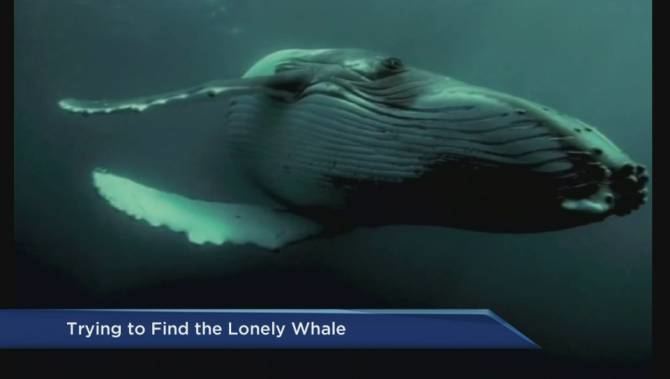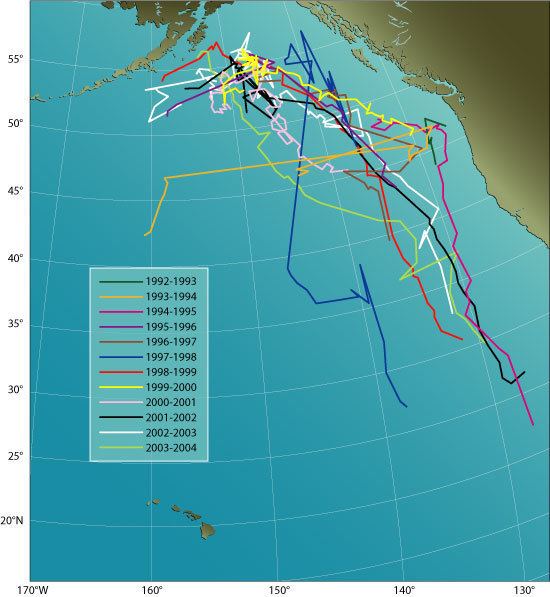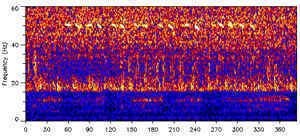 | ||
Let s play watch dogs 2 part 6 52 hertz whale
The 52-hertz whale is an individual whale of unidentified species, which calls at the very unusual frequency of 52 Hz. This pitch is a much higher frequency than that of the other whale species with migration patterns most closely resembling this whale's – the blue whale (10–39 Hz) or fin whale (20 Hz). It has been detected regularly in many locations since the late 1980s and appears to be the only individual emitting a whale call at this frequency. It has been described as the "world's loneliest whale".
Contents
- Let s play watch dogs 2 part 6 52 hertz whale
- Characteristics
- History
- Documentary
- Short film
- Music
- References

Characteristics

The sonic signature is that of a whale, albeit at a unique frequency. At 52 hertz, it is just higher than the lowest note on a tuba. The call patterns resemble neither blue nor fin whales, being much higher in frequency, shorter, and more frequent. Blue whales usually vocalize at 10–39 Hz, fin whales at 20 Hz. The 52-hertz calls of this whale are highly variable in their pattern of repetition, duration, and sequence, although they are easily identifiable due to their frequency and characteristic clustering. The calls have deepened slightly to around 49 hertz since 1992, suggesting the whale has grown or matured.

The track of the 52-hertz whale is unrelated to the presence or movement of other whale species. Its movements have been somewhat similar to that of blue whales, but its timing has been more like that of fin whales. It is detected in the Pacific Ocean every year beginning in August–December, and moves out of range of the hydrophones in January–February. It travels as far north as the Aleutian and Kodiak Islands, and as far south as the California coast, swimming between 30 and 70 km each day. Its (recorded) distance traveled per season has ranged from a low of 708 km to a high of 11,062 km in 2002–03.

Scientists at the Woods Hole Oceanographic Institution have been unable to identify the species of the whale. They speculate that it could be malformed, or a hybrid of a blue whale and another species. The research team has been contacted by deaf people who believe the whale may be deaf.

Whatever biological cause underlies its unusually high frequency voice does not seem to be detrimental to its survival. The fact that the whale has survived and apparently matured indicates it is probably healthy. Still, its unique call is the only one of its kind detected anywhere and there is only one such source per season. Because of this, the animal has been called the loneliest whale in the world.
History

The 52-hertz whale was discovered by a team from the Woods Hole Oceanographic Institution. Its call was first detected in 1989, then again in 1990 and 1991. In 1992, following the end of the Cold War, the U.S. Navy partially declassified the recordings and technical specifications of its SOSUS anti-submarine hydrophone arrays, and made SOSUS available for oceanographic research. As of 2014, the whale had been detected every year since. Research by scientists at Woods Hole has been supported by the U.S. Army Corps of Engineers, the U.S. Department of Defense, and the National Marine Fisheries Service, in addition to the U.S. Navy.
Documentary
A feature-length documentary entitled 52: The Search for the Loneliest Whale is in production, shot by Joshua Zeman, the director of Cropsey, and produced by Adrian Grenier. Funded through a Kickstarter campaign, the film is due for release sometime in 2017.
Short film
The Loneliest, a short mockumentary film about two women searching for the loneliest whale, was made in April 2014 by Lilian Mehrel, with the Alfred P. Sloan Foundation.
Music
Montreal-based saxophone player and composer Colin Stetson's 2013 album New History Warfare Vol. 3: To See More Light included a song entitled "Part of Me Apart From You". Though not explicitly written about the 52-hertz whale, when first performing the song live, he remarked on at least several occasions that the story of the "loneliest whale" resonated deeply with his composition. "This whale is alone in a large body of water, swimming, singing its song, calling for a likeness it will never find," he said by way of introducing the song at a performance at Toronto's Great Hall on 19 May 2013. "When I play this song, I can't help but think about this whale, who right at this very minute is singing alone."
South Korean hip-hop group BTS (band)'s 2015 album The Most Beautiful Moment in Life, Part 2's fourth track, Whalien 52, explicitly uses the 52-hertz whale as a metaphor for the alienation from others often felt by adolescents.
